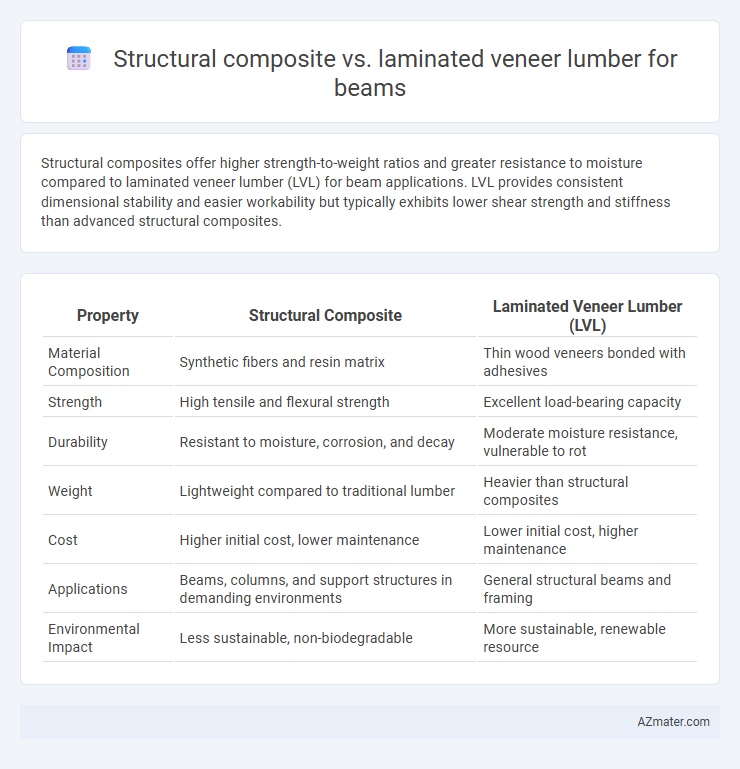Structural composites offer higher strength-to-weight ratios and greater resistance to moisture compared to laminated veneer lumber (LVL) for beam applications. LVL provides consistent dimensional stability and easier workability but typically exhibits lower shear strength and stiffness than advanced structural composites.
Table of Comparison
| Property | Structural Composite | Laminated Veneer Lumber (LVL) |
|---|---|---|
| Material Composition | Synthetic fibers and resin matrix | Thin wood veneers bonded with adhesives |
| Strength | High tensile and flexural strength | Excellent load-bearing capacity |
| Durability | Resistant to moisture, corrosion, and decay | Moderate moisture resistance, vulnerable to rot |
| Weight | Lightweight compared to traditional lumber | Heavier than structural composites |
| Cost | Higher initial cost, lower maintenance | Lower initial cost, higher maintenance |
| Applications | Beams, columns, and support structures in demanding environments | General structural beams and framing |
| Environmental Impact | Less sustainable, non-biodegradable | More sustainable, renewable resource |
Introduction to Structural Composite and Laminated Veneer Lumber
Structural Composite Lumber (SCL) is engineered wood made from wood fibers, flakes, or veneers bonded with adhesives to form strong, uniform beams ideal for high-load applications. Laminated Veneer Lumber (LVL) consists of thin wood veneers glued together with grains running parallel to enhance strength and stiffness, commonly used for beams and headers in construction. Both SCL and LVL offer superior dimensional stability and strength compared to traditional lumber, making them preferred choices for structural beams.
Material Composition and Manufacturing Processes
Structural composite beams consist of engineered wood fibers, veneers, or strands bonded together with adhesives under heat and pressure, resulting in products like laminated veneer lumber (LVL) or glued laminated timber (glulam). Laminated veneer lumber specifically features thin wood veneers glued parallel to each other, optimizing strength and stiffness for beam applications. The manufacturing of LVL involves peeling logs into veneers, drying, and pressing them with binders, creating a uniform and strong structural component distinct from other composite beams that may include strands or flakes in their matrix.
Strength and Structural Performance Comparison
Structural composite beams, such as glulam and LVL, typically exhibit higher strength-to-weight ratios compared to traditional laminated veneer lumber (LVL) due to engineered layering and adhesive bonds that enhance load distribution. LVL offers consistent dimensional stability and reduced variability in tensile and bending strength, making it a reliable choice for beams requiring predictable structural performance. Both materials provide excellent stiffness and resistance to warping, but structural composites often outperform LVL in shear strength and long-span applications, optimizing overall durability and safety in construction.
Weight and Dimensional Stability
Structural composite beams typically offer superior dimensional stability compared to laminated veneer lumber (LVL) due to their engineered composition, which minimizes warping and swelling. LVL tends to be heavier as it is manufactured from bonded wood veneers, contributing to increased dead loads in construction. Weight-conscious projects benefit from structural composites, which achieve high strength-to-weight ratios and maintain consistent dimensions under varying environmental conditions.
Durability and Resistance to Environmental Factors
Structural composite beams exhibit superior durability compared to laminated veneer lumber (LVL) due to advanced resin binders and engineered wood fibers that enhance resistance to moisture, decay, and insect damage. Laminated veneer lumber, while strong and dimensionally stable, is more prone to delamination and warping when exposed to fluctuating humidity and temperature changes over time. Choosing structural composites ensures longer service life and better performance in harsh environmental conditions such as high humidity, constant exposure to water, or insect-prone areas.
Cost Analysis and Economic Considerations
Structural composite beams, such as LVL (Laminated Veneer Lumber), generally offer higher strength-to-weight ratios compared to traditional laminated veneer lumber, influencing overall material costs. Initial manufacturing expenses for LVL are typically higher due to advanced processing techniques, but long-term economic benefits arise from reduced installation time and lower maintenance requirements. Evaluating cost-efficiency involves assessing lifecycle expenses, where structural composite beams often provide superior value in large-scale or high-load applications.
Applications in Modern Construction
Structural composite beams offer superior strength-to-weight ratios and moisture resistance, making them ideal for long-span applications in residential and commercial buildings. Laminated veneer lumber (LVL) provides consistent dimensional stability and is widely used for headers, beams, and rim boards due to its uniform strength and cost-effectiveness. Modern construction favors structural composites in environments demanding high load capacities and durability, while LVL remains popular for its ease of installation and reliable performance in standard framing.
Sustainability and Environmental Impact
Structural composites and laminated veneer lumber (LVL) both offer sustainable alternatives to traditional solid wood beams, but LVL typically has a lower environmental impact due to its efficient use of small-diameter logs and reduced waste in the manufacturing process. Structural composites often incorporate adhesives and synthetic materials, which can complicate recycling and increase the carbon footprint compared to the primarily wood-based LVL products. Selecting LVL beams supports sustainable forestry practices by utilizing fast-growing, renewable wood fibers, thereby enhancing the overall eco-efficiency of construction projects.
Installation Methods and Workability
Structural composite beams offer enhanced workability due to their engineered consistency and precision-cut dimensions, making installation faster and more predictable compared to laminated veneer lumber (LVL). LVL beams require careful handling and often on-site adjustments because of their thicker layers, which can complicate fastening and fitting in tight spaces. Both materials allow for standard installation techniques, but structural composites typically reduce labor time and improve ease of alignment during beam placement.
Choosing the Right Material for Beam Applications
Structural composite beams offer higher strength-to-weight ratios and enhanced durability, making them ideal for long spans and heavy loads in construction. Laminated veneer lumber (LVL) provides consistent quality with excellent dimensional stability and resistance to warping, suitable for applications requiring precision and uniformity. Selecting between structural composite and LVL depends on project-specific load requirements, environmental exposure, and budget constraints.

Infographic: Structural composite vs Laminated veneer lumber for Beam
 azmater.com
azmater.com